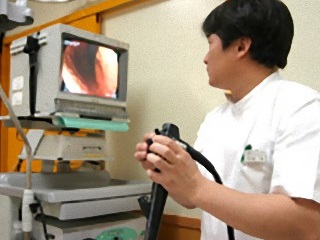(Wouldn't you be interested in our hypersensitivity enteritis diagnosis?)
There is a disease called "collagenous colitis". I imagine if you are not a digestive organs specialist you may never have heard of this disease. At this moment, there is still not even a suitable Japanese name for this disease. In 2001 in the Japan Medical Conference Journal on Digestion I entitled the disease in Japanese,“Kougensen-i sei daichoen". Near the bottom of the mucous membrane of the colon there is a thick (about 0.01mm) collagen band, which is susceptible to hyperplasia (increased growth of cells). If this happens, the colon is unable to absorb water and thus an aqueous solution (diarrhea) is the end product of digestion. The cause of this disease is unknown however; we think may be a side effect from a drug that alters the immune system. According to clinical observation, middle-aged women and older (sex ratio: female 9, male 1) are most likely to have this chronic disorder.
Endoscopic findings of this disease are considered as normal. Here is an outline of this disease's first diagnosis under the microscope, starting off with a tissue collection from the mucous membrane. A pathologist named Dr. Lindstrom first discovered this disease in Sweden in 1976. After the discovery of this disease there were hundreds of cases reported in America and Europe, nowadays this disease is not rare. While I worked in Sweden at Lund University Malmo Hospital, Dr. Lindstrom was a professor in the pathology department. During the time I was at Malmo Hospital he had already retired, however I was often called on to do endoscopic examinations on patients who suffered from this disease. In America and Europe, the use of an endoscope is very common; in Japan I have come to realize we are not as thorough in our methods when making observations with an endoscope. Because of my extensive use of the endoscope I may have left out a detail or note, thus if you are interested in learning more about this topic, I am more than happy to recommend some follow up reading.
Here is a list of articles:
Sato S, Benoni C, Toth E, et al: Chromoendoscopic appearance of collagenous colitis- a case report using indigo carmine. Endoscopy (7)30, S80-81, 1997. English
Sato S, Frans Thomas Fork: Collagenous colitis. An atlas of the stomach and intestines II, 494-495, Medical Publishing、2001. Japanese
Sato S, Matsui T、Yao T, :Special Ed. Most recent ailments of inflammation of the intestine (excluding IBD) 7. Collagenous colitis and lymphocyte colitis. Japan Medical Conference Journal on Digestion, 54(10), 960-964, 2001. Japanese
Sato S, Matsui T, Tsuda, et al: Endoscopic abnormalities in a Japanese patient with collagenous colitis. J Gastroenterol 38(8), 812-813, 2003. English
Sato S: Collagenous colitis. The Endoscope, observations and diagnosis of digestive diseases. Japan Medical Center, 2005. Japanese
Sato S: Collagenous colitis. Practical guide for management in Gastroenterology, Bunkoudou, 2005. Japanese
In recent years, the concept of this disease has become more recognized in our country little by little. In 2009, a special issue was released in a magazine, Stomach and intestine, for specialists. However, a common awareness amongst physicians in general has yet to be achieved. There may be doctors who diagnosis this condition as 'irritable colon syndrome' or 'hypersensitive colon' and label stress as the cause, however I hope you will consider my work next time your patient undergoes a endoscopic examination of the colon.


